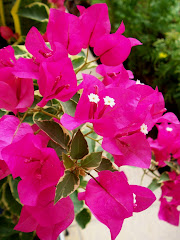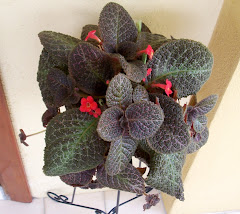
We've planted
African marigolds; yellow
'Doubloon' and deep orange
'Double Eagle' behind our Zinnias.

A full bloomed African marigold risk bent-neck or stooping down, heavy from watering. If we're lucky, the bloom may rise when dry and light but usually the bloom fades faster if bent.
I had to staked one of the Marigolds after a heavy downpour. It was bent at the base just above the soil level.A good Marigold bloom last 2 weeks before turning ugly brown while attached to its stem.
Could be the hot weather causing the bloom to dry up prematurely. Sadly this hot weather, said to last til September.


Buds starting to bloom (pic). Petals folded in the flowerhead, curls out as it unfolds & grows.Colours were so bright that I had to darken for light shadows to view the curls on petals. It was a harder task than roses.
Marigolds are categorized into 4 groups: French, African, Triploid and Single.
- French marigolds (Tagetes patula) > small bushy, 12" ht, flowers 2" (5 cm) across.
- African marigolds (Tagetes erecta) > tall stout, 3 ft ht, larger blossoms like pom-pom but shorter flowering period (p/s-remove faded flowers to encourage a second flush of bloom).
- Triploid marigolds > sterile hybrids (French + African), non-stop bloomers with impressive 3" flower heads in warm colors of gold, yellow, red and russet.
- Single Marigolds (Tagetes tenuifolia (signata) pumila) > simple, daisy-like blooms and long stems; some varieties of merit are Cinnabar, Burgundy, Ripples and Chippendale Daisy.
The leaves of all marigolds are dark green, deeply divided and have a somewhat unpleasant, aromatic fragrance.
- Growing: Marigolds are not fussy, they will adapt to most garden soils.
- Light: Full sun.
- Moisture: Water during periods of drought.
- Propagation: The black needle-like seeds can be easily sown directly where they are to be grown. Seedlings are 2" long.
- Hardiness: Marigolds are tender tropical plants and are killed by frost. Minimum 6 hours of direct sunlight. Resistance to disease and pests.
Use: Common, inexpensive and easy to germinate, and grow in beds and borders. Blooms non-stop. Some advice to plant marigolds in the vegetable garden to discourage certain insect pests. Summer care of marigolds is simple. Water occasionally during dry weather and pinch off faded flowers to encourage additional bloom. Tall African marigolds may require staking to prevent the plants from falling over or lodging during storms. Marigolds require approximately 45 to 50 days to flower after seeding.
http://marvelousmarigolds.wordpress.com/
http://urbanext.illinois.edu/hortanswers/plantdetail.cfm?PlantID=768&PlantTypeID=1

Gromphrenas (upclose).






































